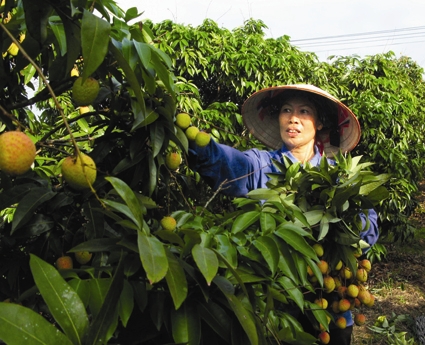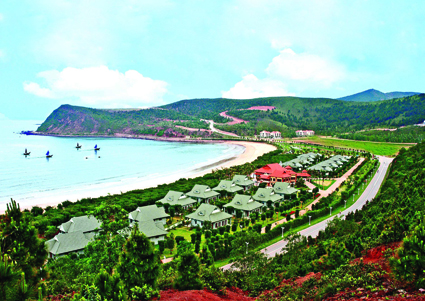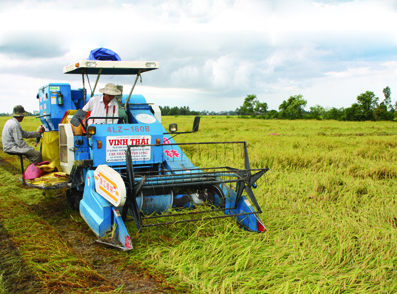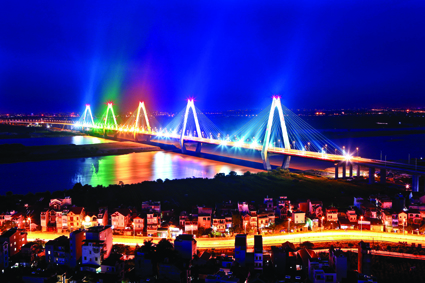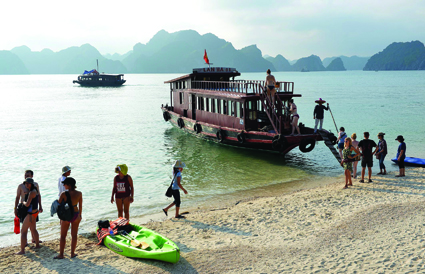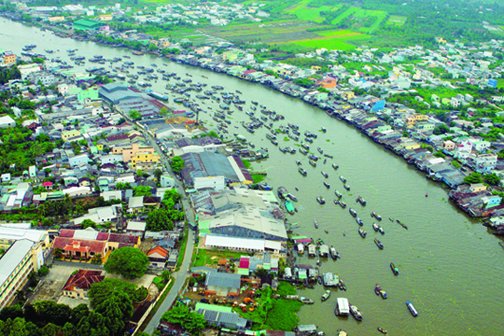Located in the southern key economic region, Ba Ria-Vung Tau province borders Ho Chi Minh City to the west, Dong Nai province to the north, Binh Thuan province to the east and the East Sea to the south. Covering an area of 1,989.6 square kilometers and having a population of more than 1 million (by 2010), Ba Ria-Vung Tau has two cities (Vung Tau and Ba Ria) and six districts, namely Chau Duc, Long Dien, Tan Thanh, Xuyen Moc, Dat Do and Con Dao (island district).
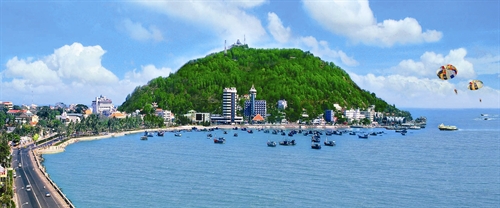 |
| Green and blue of Vung Tau city (Ba Ria - Vung Tau)__Photo: Internet |
Open investment opportunities
Lying on the trans-Asia axis, Ba Ria-Vung Tau boasts strengths and potential to develop its sea economy, including tourism, oil and gas, seafood exploitation and processing. It has convenient seaport, airport and waterway transport networks. With the depth of navigable channels of up to 14 meters and a total designed handling capacity of 250 million tons/year by 2020, the province’s 20-km deepwater Cai Mep-Thi Vai seaport complex is a national general port and an international gateway port capable of receiving vessels of a tonnage of up to 157,000 DWT. Goods exported from Cai Mep-Thi Vai seaport can be shipped directly to the US and other countries and territories around the world without calling at transshipment ports. The deepwater seaport system facilitates Ba Ria-Vung Tau in developing commercial services, industry, import and export.
Ba Ria-Vung Tau has very convenient traffic systems for international trade, with national highway sections running close to its industrial parks, ports and tourism sites. Apart from Ho Chi Minh City-based Tan Son Nhat International Airport, the Long Thanh International Airport to be built in Dong Nai province and expected to be commissioned in 2020 is only 30 kilometers from Cai Mep-Thi Vai seaport complex. As planned, several key national transport projects will be constructed and put into operation before 2020, including some expressways and Bien Hoa-Vung Tau railway.
At present, Ba Ria-Vung Tau has 14 industrial parks (IPs) covering 8,400 hectares, close to the Thi Vai-Cai Mep seaport complex. The industrial sector makes up 48 percent while logistics services represent nine percent of the province’s total foreign direct investment (FDI) capital. Industrial production projects are mainly located in IPs while logistics service projects can be found everywhere in the province. Noteworthy, Phu My 3 IP has been chosen to be developed into a specialized IP to attract Japanese investors in supporting industries. Once operational, the IP will become a major driving force for accelerating the province’s economic restructuring towards industrialization, contributing to developing hi-tech enterprises.
According to the Ba Ria-Vung Tau Planning and Investment Department, in the first half of the year, the province granted investment licenses to five new FDI projects totaling USD 152.6 million and permitted six existing projects to add USD 94.8 million to their registered investment capital and one ongoing project to reduce its investment capital to USD 6.3 million. The province has so far attracted a total of 292 FDI projects with a combined registered capital amount of more than USD 27 billion. Around USD 10.2 billion have so far been disbursed, focusing on a number of large-scale projects such as the Posco SS-Vina and Vina Kyoei steel mills.
Along with supporting industries, logistics services are a spearhead economic sector that is incorporated in the province’s economic restructuring program. From now until 2020, it will prioritize the development of the 800-hectare Cai Mep ha (lower Cai Mep) logistics service center and a 93-hectare logistics service area in Sao Mai-Ben Dinh. At present, administrative procedures for investment in the field are being carried out under the single-window mechanism, said deputy director of Ba Ria-Vung Tau Planning and Investment Department Dang Minh Thong. However, he said, as per the current regulations on investment and corporate income tax, logistics services were ineligible for investment incentives.
To attract investors to the field, the Ba Ria-Vung Tau People’s Committee has formulated incentive regimes. Accordingly, an enterprise established under a logistic service investment project in an area with extreme socio-economic difficulties like Con Dao island district will enjoy a corporate income tax rate of 10 percent for 15 years after being entitled to tax exemption for four years and 50-percent tax reduction in the subsequent nine years. They will also enjoy land rental exemption for 11 years after its project commences operation. In particular, enterprises in Tan Thanh district will enjoy a corporate income tax rate of 20 percent for 10 years after being entitled to tax exemption for two years and 50-percent tax reduction in the subsequent four years. They will also enjoy land rental exemption for seven years after their projects commence operation. In addition to the above incentives, investors in logistics sector will receive assistance in human resources training, Thong said.
Through 2020, the province will call for investment in 151 projects specializing in tourism, traffic infrastructure, commerce, metallurgy-mechanical engineering, agriculture, logistics infrastructure, high technology, processing and oil refinery. The province will strive to lure international conglomerates and companies from around the world, but focusing on ASEAN countries, Japan, the Republic of Korea, Europe and America. Nevertheless, the province will surely reject investment projects that are labor-intensive or use obsolete technologies and threaten to cause environmental pollution or affect national defense and security.
To attract investors, the province vows to support owners of IP technical infrastructure project in speeding up ground clearance and investing in infrastructure facilities under the approved planning.
Apart from the investment promotion and acceleration of administrative procedure reform and maintenance of Japan Desk, a service to assist Japanese businesses with an aim to improve the business environment and promoting Japanese investment in the locality, Ba Ria-Vung Tau will host frequent dialogues with investors to promptly understand their conditions and needs, listen to their recommendations and discuss with them on addressing difficulties and problems. Furthermore, the province will focus on upgrading and improving the transport infrastructure system connected to deepwater seaports as well as road and seashipping routes to other localities in the southern key economic region for better goods transportation and circulation.
Tourism potential
With cool and dry temperature all year round and a coastline of 305.4km, Ba Ria-Vung Tau is an ideal place for sea sports tourism and development of deluxe seaside resorts. The province is famous for not only crystal clear water and white sandy beaches but also cultural, revolutionary and historic relics. It also has three ports - the Sai Gon Vietnam and SP-PSA international ports and Tan Cang-Cai Mep port - that are capable of accommodating international cruise ships. The province has 195 operational hotels and resorts with more than 8,300 rooms, with 114 hotels ranked from one to five stars. Many new accommodation establishments have been put into service, including five-star Imperial Hotel, Vung Tau Car Cable Resort, Sixsenses Con Dao Resort and Ho Tram Asean Coast Resort.
The Ba Ria-Vung Tau Culture, Sports and Tourism Department reported that the province welcomed more than 8.5 million tourists, including around 290,000 foreign holiday makers, and earned more than VND 1.15 trillion in the first half of the year.
The achievement was attributed to local authorities’ efforts to promote and diversify tourist products and the operation of regional luxury resorts like the Grand Ho Tram Strip and Vietsovpetro Ho Tram Resort, said the department.
At present, the province is home to 157 tourism investment projects, including 18 FDI projects, covering a total area of 3,400 hectares, and 41 others located in 3,300 hectares of forestry land.
The province plans to receive more than 15 million tourists, including 545,000 foreign arrivals, earning a gross revenue of over VND 3.72 trillion this year.
Ho Van Loi, director of the Ba Ria-Vung Tau Culture, Sports and Tourism Department, said that aiming to achieve the targets, the local tourism sector would focus on finalizing the provincial master plan on tourism development through 2020, with a vision to 2030; addressing difficulties facing tourism companies; improving the quality of festivals and events; selecting a number of typical relics for restoration; and devising schemes to support vocational skill training for tourism workers.- (VLLF)
